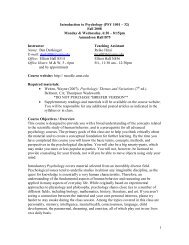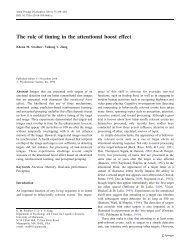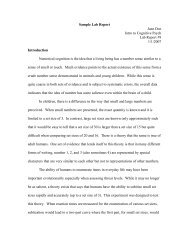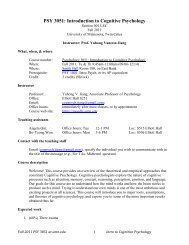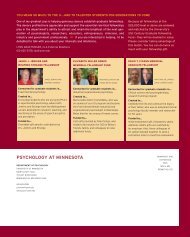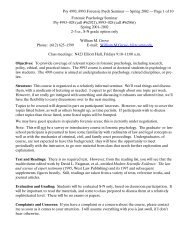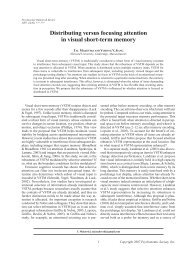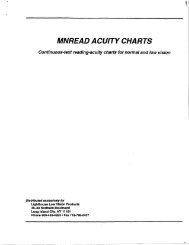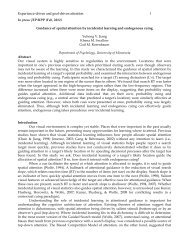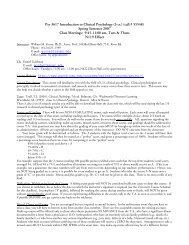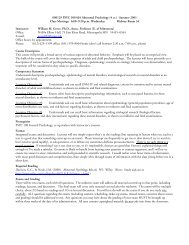Neural Activity in the Hippocampus and Perirhinal Cortex during ...
Neural Activity in the Hippocampus and Perirhinal Cortex during ...
Neural Activity in the Hippocampus and Perirhinal Cortex during ...
Create successful ePaper yourself
Turn your PDF publications into a flip-book with our unique Google optimized e-Paper software.
<strong>Neural</strong> <strong>Activity</strong> <strong>in</strong> <strong>the</strong> <strong>Hippocampus</strong> <strong>and</strong> Perirh<strong>in</strong>al <strong>Cortex</strong>dur<strong>in</strong>g Encod<strong>in</strong>g Is Associated with <strong>the</strong> Durabilityof Episodic MemoryValerie A. Carr*, Indre V. Viskontas*, Stephen A. Engel,<strong>and</strong> Barbara J. KnowltonAbstract■ Studies exam<strong>in</strong><strong>in</strong>g medial temporal lobe (MTL) <strong>in</strong>volvement <strong>in</strong>memory formation typically assess memory performance after as<strong>in</strong>gle, short delay. Thus, <strong>the</strong> relationship between MTL encod<strong>in</strong>gactivity <strong>and</strong> memory durability over time rema<strong>in</strong>s poorly characterized.To explore this relationship, we scanned participants us<strong>in</strong>ghigh-resolution functional imag<strong>in</strong>g of <strong>the</strong> MTL as <strong>the</strong>y encoded objectpairs; us<strong>in</strong>g <strong>the</strong> remember/know paradigm, we <strong>the</strong>n assessedmemory performance for studied items both 10 m<strong>in</strong> <strong>and</strong> 1 weeklater. Encod<strong>in</strong>g trials were classified as ei<strong>the</strong>r subsequently recollectedacross both delays, transiently recollected (i.e., recollectedat 10 m<strong>in</strong> but not after 1 week), consistently familiar, or consistentlyforgotten. <strong>Activity</strong> <strong>in</strong> perirh<strong>in</strong>al cortex (PRC) <strong>and</strong> a hippocampalsubfield compris<strong>in</strong>g <strong>the</strong> dentate gyrus <strong>and</strong> CA fields 2<strong>and</strong> 3 reflected successful encod<strong>in</strong>g only when items were recollectedconsistently across both delays. Fur<strong>the</strong>rmore, <strong>in</strong> PRC, encod<strong>in</strong>gactivity for items that later were consistently recollectedwas significantly greater than that for transiently recollected <strong>and</strong>consistently familiar items. Parahippocampal cortex, <strong>in</strong> contrast,showed a subsequent memory effect dur<strong>in</strong>g encod<strong>in</strong>g of itemsthat were recollected after 10 m<strong>in</strong>, regardless of whe<strong>the</strong>r <strong>the</strong>yalso were recollected after 1 week. These data suggest that MTLsubfields contribute uniquely to <strong>the</strong> formation of memories thatendure over time, <strong>and</strong> highlight a role for PRC <strong>in</strong> support<strong>in</strong>g subsequentdurable episodic recollection. ■INTRODUCTIONShortly follow<strong>in</strong>g an event, we often have a vivid episodicmemory for what transpired, yet over time, this vividnessmay fade or <strong>the</strong> event may be forgotten altoge<strong>the</strong>r. Foro<strong>the</strong>r events our memories endure, <strong>and</strong> we are able torecollect details of <strong>the</strong> event over extended periods. Whatneural mechanisms might account for <strong>the</strong>se differences <strong>in</strong><strong>the</strong> durability of memory? The medial temporal lobe(MTL) is known to play a key role <strong>in</strong> both encod<strong>in</strong>g <strong>and</strong>retriev<strong>in</strong>g declarative memories (for a review, see, e.g.,Squire, Stark, & Clark, 2004). It rema<strong>in</strong>s unclear, however,how <strong>the</strong> strength of encod<strong>in</strong>g with<strong>in</strong> this region <strong>in</strong>fluencesmemory durability, given that factors occurr<strong>in</strong>g postencod<strong>in</strong>g,such as memory consolidation <strong>and</strong> retrievalaccessibility, also affect memory durability. Fur<strong>the</strong>rmore,<strong>the</strong> manner <strong>in</strong> which <strong>the</strong> hippocampal region (subiculum,CA fields, <strong>and</strong> dentate gyrus) <strong>and</strong> surround<strong>in</strong>g cortical regions(parahippocampal [PHC], perirh<strong>in</strong>al [PRC], <strong>and</strong> entorh<strong>in</strong>al[ERC] cortices) contribute to successful encod<strong>in</strong>grema<strong>in</strong>s controversial. Us<strong>in</strong>g high-resolution fMRI of <strong>the</strong>MTL to bridge <strong>the</strong>se two areas of research, <strong>the</strong> currentUniversity of California, Los Angeles*These authors contributed equally to this work.study aimed to evaluate <strong>the</strong> potential for functional heterogeneityamong MTL subfields <strong>in</strong> support<strong>in</strong>g <strong>the</strong> formationof vivid memories that endure over time.F<strong>in</strong>d<strong>in</strong>gs from st<strong>and</strong>ard-resolution imag<strong>in</strong>g studieslend support to <strong>the</strong> notion that subsequent memory success<strong>and</strong> MTL encod<strong>in</strong>g activity are related, although suchstudies typically assess memory performance after a s<strong>in</strong>gle,short delay (e.g., less than 24 hr), <strong>and</strong> thus, do not speakdirectly to <strong>the</strong> issue of memory durability. For example,early fMRI studies exam<strong>in</strong><strong>in</strong>g <strong>the</strong> relationship betweenencod<strong>in</strong>g activity <strong>and</strong> subsequent memory success demonstrated<strong>in</strong>creased encod<strong>in</strong>g activity for subsequentlyrecognized versus forgotten items <strong>in</strong> <strong>the</strong> parahippocampalgyrus (Brewer, Zhao, Desmond, Glover, & Gabrieli, 1998;Wagner et al., 1998), as well as <strong>in</strong>creased hippocampal activityfor successfully versus unsuccessfully recalled words(Fern<strong>and</strong>ez et al., 1998). Several <strong>the</strong>ories of MTL function,however, suggest that <strong>the</strong> hippocampus <strong>and</strong> surround<strong>in</strong>gcortices differentially support encod<strong>in</strong>g of new memories,although <strong>the</strong> organiz<strong>in</strong>g pr<strong>in</strong>ciples underly<strong>in</strong>g such differencesrema<strong>in</strong> a topic of debate.Build<strong>in</strong>g from MTL anatomy <strong>and</strong> neural network pr<strong>in</strong>ciples,several computational <strong>the</strong>ories posit that MTL corticesare specialized for slowly develop<strong>in</strong>g representationsof generalities <strong>in</strong> <strong>the</strong> environment, such that similar representationsare assigned to similar stimuli. Conversely, such© 2009 Massachusetts Institute of Technology Journal of Cognitive Neuroscience 22:11, pp. 2652–2662
models propose that <strong>the</strong> hippocampus plays a key role <strong>in</strong>assign<strong>in</strong>g dist<strong>in</strong>ct representations to cortical <strong>in</strong>put patterns,<strong>and</strong> for b<strong>in</strong>d<strong>in</strong>g co-occurr<strong>in</strong>g <strong>in</strong>put patterns <strong>in</strong>to cohesiveevent memories (Norman & OʼReilly, 2003). Differences<strong>in</strong> <strong>the</strong> way <strong>in</strong>formation is represented <strong>in</strong> <strong>the</strong>se structuresare <strong>the</strong>n thought to lead to regional differences <strong>in</strong> support<strong>in</strong>grecognition memory. Specifically, such computational<strong>the</strong>ories suggest that <strong>the</strong> hippocampus encodes patternsof cortical <strong>in</strong>put <strong>in</strong> a manner that supports subsequent detailedrecollection of episodes, whereas MTL cortices arethought to be <strong>in</strong>capable of support<strong>in</strong>g memory for specificevents due to encod<strong>in</strong>g of overlapp<strong>in</strong>g representations, <strong>and</strong><strong>in</strong>stead enable a sense of familiarity (Norman & OʼReilly,2003; OʼReilly & Rudy, 2001). Additional support for thisdivision of labor comes from <strong>the</strong>ories of MTL functionbased upon empirical f<strong>in</strong>d<strong>in</strong>gs <strong>in</strong> animals <strong>and</strong> humans suggest<strong>in</strong>gthat <strong>the</strong> hippocampus <strong>and</strong> PRC make dissociablecontributions to recognition memory (Brown & Aggleton,2001; Aggleton & Brown, 1999).Support from neuroimag<strong>in</strong>g studies for this hippocampal/cortical dist<strong>in</strong>ction has been equivocal, however. Severalrecent reviews of <strong>the</strong> MTL literature suggest a commonpattern of f<strong>in</strong>d<strong>in</strong>gs such that anterior portions of <strong>the</strong> parahippocampalgyrus (typically assumed to map onto PRC)support encod<strong>in</strong>g of <strong>the</strong> <strong>in</strong>dividual elements of an eventlead<strong>in</strong>g to subsequent feel<strong>in</strong>gs of familiarity, whereas <strong>the</strong>posterior extent (PHC) supports encod<strong>in</strong>g of spatial <strong>in</strong>formation<strong>and</strong> <strong>the</strong> context <strong>in</strong> which <strong>in</strong>dividual elementsoccur, enabl<strong>in</strong>g later episodic recollection. The hippocampusis thought to b<strong>in</strong>d toge<strong>the</strong>r <strong>the</strong>se different aspects ofan experience <strong>in</strong>to a cohesive event memory that latercan be recollected <strong>in</strong> detail (Diana, Yonel<strong>in</strong>as, & Ranganath,2007; Eichenbaum, Yonel<strong>in</strong>as, & Ranganath, 2007; Davachi,2006). These f<strong>in</strong>d<strong>in</strong>gs support <strong>the</strong> idea that both <strong>the</strong> hippocampus<strong>and</strong> PHC are <strong>in</strong>volved <strong>in</strong> encod<strong>in</strong>g episodicmemories, but that each regionʼs contribution to subsequentrecollection is different. Fur<strong>the</strong>rmore, emerg<strong>in</strong>g datasuggest that although PRC may play a key role <strong>in</strong> item encod<strong>in</strong>g,under certa<strong>in</strong> conditions, this region may also supportencod<strong>in</strong>g of associations between items or betweenitems <strong>and</strong> <strong>the</strong>ir features (Hask<strong>in</strong>s, Yonel<strong>in</strong>as, Quamme, &Ranganath, 2008; Stares<strong>in</strong>a & Davachi, 2006, 2008; Tendolkaret al., 2007), suggest<strong>in</strong>g that later associative recollection maydepend on PRC activity dur<strong>in</strong>g encod<strong>in</strong>g. F<strong>in</strong>ally, although<strong>the</strong>re is broad agreement regard<strong>in</strong>g <strong>the</strong> role of <strong>the</strong> hippocampus<strong>in</strong> encod<strong>in</strong>g <strong>in</strong>formation <strong>in</strong> a manner that enableslater recollection, controversy exists regard<strong>in</strong>g <strong>the</strong> degreeto which this region selectively supports recollection dur<strong>in</strong>gretrieval (e.g., Squire, Wixted, & Clark, 2007; Squire et al.,2004).These f<strong>in</strong>d<strong>in</strong>gs have led several researchers to concludethat draw<strong>in</strong>g a sharp dist<strong>in</strong>ction between <strong>the</strong> hippocampus<strong>and</strong> parahippocampal gyrus <strong>in</strong> encod<strong>in</strong>g<strong>in</strong>formation <strong>in</strong> a manner supportive of later recollection<strong>and</strong> familiarity, respectively, is an oversimplified descriptionof MTL function (Diana et al., 2007; Eichenbaum et al.,2007; Davachi, 2006; Squire et al., 2004). Thus, although<strong>the</strong>re is little doubt that MTL encod<strong>in</strong>g activity positively correlateswith future memory success, additional research isrequired to better underst<strong>and</strong> <strong>the</strong> precise manner <strong>and</strong> conditionsunder which <strong>the</strong> hippocampus <strong>and</strong> adjacent corticalregions support encod<strong>in</strong>g of memories subsequently recollected<strong>in</strong> vivid detail versus those judged merely familiar.Fur<strong>the</strong>rmore, <strong>the</strong> vast majority of studies attempt<strong>in</strong>g toelucidate <strong>the</strong> role of <strong>the</strong> hippocampus <strong>and</strong> MTL cortices<strong>in</strong> form<strong>in</strong>g new memories has evaluated memory performanceafter a short delay, <strong>and</strong> thus, does not offer <strong>in</strong>sights<strong>in</strong>to MTL contributions to form<strong>in</strong>g memories that endureover time.One exception is a recent whole-bra<strong>in</strong> study (Uncapher& Rugg, 2005) <strong>in</strong> which participants first encoded a set ofitems while undergo<strong>in</strong>g fMRI, <strong>and</strong> <strong>the</strong>n were tested on halfof <strong>the</strong> studied items after a 30-m<strong>in</strong> delay, with <strong>the</strong> rema<strong>in</strong><strong>in</strong>ghalf tested after a 48-hr delay. The authors found thatencod<strong>in</strong>g activity <strong>in</strong> <strong>the</strong> anterior hippocampus was associatedwith successful recollection at both <strong>the</strong> 30-m<strong>in</strong><strong>and</strong> 48-hr delay, <strong>and</strong> that activity <strong>in</strong> <strong>the</strong> parahippocampalgyrus was correlated with successful familiarity-based recognitionat both delays. Although this procedure enabled<strong>the</strong> authors to exam<strong>in</strong>e <strong>the</strong> relationship between encod<strong>in</strong>gactivity <strong>and</strong> subsequent memory success at ei<strong>the</strong>r ashort or long delay, test<strong>in</strong>g different sets of items at <strong>the</strong>two time po<strong>in</strong>ts limited <strong>the</strong> authorsʼ ability to assess howdurable a given memory was over time. For example, itemssuccessfully recollected at <strong>the</strong> short delay likely <strong>in</strong>cludeditems that would have lost <strong>the</strong>ir associated episodic characterover <strong>the</strong> 48-hr delay. Similarly, a portion of itemsdeemed familiar at <strong>the</strong> long delay likely would have beenrecollected <strong>in</strong>itially had <strong>the</strong>y been tested.Us<strong>in</strong>g a task design that enabled us to track participantsʼmemory across a short <strong>and</strong> long delay, <strong>the</strong> currentstudy aimed to directly address <strong>the</strong> hypo<strong>the</strong>sis that MTLencod<strong>in</strong>g activity relates to how durable a given memoryis over time. To this end, we used high-resolution fMRI tomeasure patterns of MTL encod<strong>in</strong>g activity as participantsstudied a series of object pairs. We <strong>the</strong>n assessed memoryperformance for <strong>the</strong> same items 10 m<strong>in</strong> <strong>and</strong> 1 week after<strong>the</strong> <strong>in</strong>itial encod<strong>in</strong>g session us<strong>in</strong>g <strong>the</strong> remember/knowprocedure (Tulv<strong>in</strong>g, 1985). Based upon behavioral performance,we evaluated MTL encod<strong>in</strong>g activity associatedwith items subsequently recollected across both delays<strong>and</strong> contrasted it with activity associated with items <strong>in</strong>itiallyrecollected but later deemed familiar (“transientlyrecollected”), items consistently familiar, <strong>and</strong> items consistentlyforgotten. Fur<strong>the</strong>rmore, our use of high-resolutionimag<strong>in</strong>g of <strong>the</strong> MTL allowed for precise localization of subfieldswith<strong>in</strong> <strong>the</strong> hippocampus <strong>and</strong> parahippocampalgyrus, which <strong>in</strong> turn, enabled us to evaluate <strong>the</strong> potentialfor functional heterogeneity among subfields <strong>in</strong> support<strong>in</strong>gvivid, durable memories.Tak<strong>in</strong>g <strong>the</strong> view that <strong>the</strong> unique anatomy <strong>and</strong> connectivityof <strong>the</strong> hippocampus is specialized to support episodicencod<strong>in</strong>g, we hypo<strong>the</strong>sized that <strong>the</strong> hippocampus wouldbe most active dur<strong>in</strong>g encod<strong>in</strong>g of consistently recollectedCarr et al. 2653
memories. Thus, consistently recollected items shouldbe associated with greater hippocampal activity dur<strong>in</strong>gencod<strong>in</strong>g than those that are transiently recollected, consistentlyfamiliar, or consistently forgotten. Regard<strong>in</strong>g MTLcortical activity, two alternate predictions were made. Severalcomputational models posit that <strong>the</strong> MTL cortices donot specifically contribute to episodic encod<strong>in</strong>g; thus, activityacross conditions should not differ with <strong>the</strong> exception ofa general subsequent memory effect (greater activity forsubsequently successful than unsuccessful recognition, regardlessof whe<strong>the</strong>r <strong>the</strong> memory was episodic). In contrast,<strong>the</strong>ories of MTL function based upon f<strong>in</strong>d<strong>in</strong>gs <strong>in</strong> <strong>the</strong> neuroimag<strong>in</strong>gliterature suggest that PHC is <strong>in</strong>volved <strong>in</strong> encod<strong>in</strong>gof spatial or contextual <strong>in</strong>formation that supports subsequentepisodic recollection. Given that our stimuli are notobviously spatial <strong>in</strong> nature, it was unclear to what degree<strong>the</strong>y would engage PHC; however, <strong>the</strong>ories regard<strong>in</strong>g abroader role of this region <strong>in</strong> process<strong>in</strong>g contextual <strong>in</strong>formationsuggest that it might exhibit a similar pattern of activityas that <strong>in</strong> <strong>the</strong> hippocampus. F<strong>in</strong>ally, although PRC is widelythought to encode item <strong>in</strong>formation supportive of subsequentfeel<strong>in</strong>gs of familiarity, emerg<strong>in</strong>g data suggest that thisregion may engage <strong>in</strong> encod<strong>in</strong>g certa<strong>in</strong> forms of associationscapable of support<strong>in</strong>g later recollection. For this reason,we did not make strong hypo<strong>the</strong>ses regard<strong>in</strong>g <strong>the</strong>relationship between PRC encod<strong>in</strong>g activity <strong>and</strong> <strong>the</strong> subsequentdurability of episodic memory.EXPERIMENTAL METHODSParticipantsTwelve healthy <strong>in</strong>dividuals (6 women), of whom all butone were right-h<strong>and</strong>ed, participated <strong>in</strong> this study. The <strong>in</strong>clusionof <strong>the</strong> left-h<strong>and</strong>ed participantʼs data did not change<strong>the</strong> overall pattern of results, thus data from all 12 participantsare described here<strong>in</strong>. Participants were fluent Englishspeakers <strong>and</strong> between 25 <strong>and</strong> 30 years of age (mean =27.9 ± 2.15). Each participant was paid $100 for participation<strong>in</strong> this study. The study was performed under a protocolapproved by <strong>the</strong> UCLA Office for Protection of ResearchParticipants.MaterialsAt encod<strong>in</strong>g, participants viewed 150 object pairs (Snodgrass& V<strong>and</strong>erwart, 1980) with associated object names pr<strong>in</strong>ted below<strong>the</strong> pictures. Pairs were presented <strong>in</strong> two orientations—horizontally or vertically—<strong>and</strong> <strong>the</strong> first or “cue” item of eachpair was presented <strong>in</strong> one of four colors: blue, yellow, p<strong>in</strong>k, orgreen. The second object was always presented <strong>in</strong> black <strong>and</strong>white (see Figure 1). For counterbalanc<strong>in</strong>g purposes, eachorientation <strong>and</strong> color appeared with approximately <strong>the</strong> samefrequency; additionally, <strong>in</strong> order to counterbalance stimuliused for cues <strong>and</strong> lures, we assigned each participant to oneof two groups. One-third of <strong>the</strong> object pairs were unique toFigure 1. Encod<strong>in</strong>g paradigm.Object pairs differed <strong>in</strong> color<strong>and</strong> orientation on <strong>the</strong> screen,<strong>and</strong> participants were <strong>in</strong>structedto imag<strong>in</strong>e items with<strong>in</strong> a pair<strong>in</strong>teract<strong>in</strong>g with one ano<strong>the</strong>r.2654 Journal of Cognitive Neuroscience Volume 22, Number 11
each group, <strong>and</strong> two-thirds were seen by both groups. For<strong>the</strong> nonoverlapp<strong>in</strong>g pairs, <strong>the</strong>se items served as lures for <strong>the</strong>o<strong>the</strong>r group dur<strong>in</strong>g retrieval. Retrieval stimuli consisted of150 words correspond<strong>in</strong>g to <strong>the</strong> cue items from <strong>the</strong> studyphase, as well as 78 unstudied lure words. Although cueitems rema<strong>in</strong>ed <strong>the</strong> same for <strong>the</strong> 10-m<strong>in</strong> <strong>and</strong> 1-week recognitiontests, unique lures were used at each time po<strong>in</strong>t.While be<strong>in</strong>g scanned, participants viewed stimuli viamagnet-compatible goggles placed directly over <strong>the</strong> eyes(Resonance Technology Co., Inc., Northridge, CA). All stimuliwere presented on a Mac<strong>in</strong>tosh Powerbook G4 computerus<strong>in</strong>g <strong>the</strong> MATLAB Psychophysics Toolbox.ProcedureParticipants were scanned dur<strong>in</strong>g <strong>in</strong>tentional encod<strong>in</strong>g ofobject pairs. They were <strong>in</strong>structed to imag<strong>in</strong>e <strong>the</strong> objectswith<strong>in</strong> each pair <strong>in</strong>teract<strong>in</strong>g, <strong>and</strong> to remember <strong>the</strong> detailsof each display as best as <strong>the</strong>y could for a memory test follow<strong>in</strong>g<strong>the</strong> encod<strong>in</strong>g phase. Ten m<strong>in</strong>utes later, participantsperformed <strong>the</strong> first of two recognition tests <strong>in</strong> which <strong>the</strong>ymade a studied/new judgment followed by a remember/know judgment for those items deemed as studied. Thistwo-step procedure has been shown to reduce participantsʼtendency to use <strong>the</strong> remember/know judgment as asimple confidence decision (Eldridge, Sarfatti, & Knowlton,2002). Participants were told to give an “R” response when<strong>the</strong>y remembered <strong>the</strong> moment dur<strong>in</strong>g which <strong>the</strong>y had studied<strong>the</strong> item, <strong>and</strong> to give a “K” response when <strong>the</strong>y confidentlyrecognized an item <strong>in</strong> <strong>the</strong> absence of recollection.To ensure that participants properly understood this dist<strong>in</strong>ction,<strong>the</strong>y were asked to def<strong>in</strong>e remember <strong>and</strong> know<strong>in</strong> <strong>the</strong>ir own words <strong>and</strong> to offer an example of each beforebeg<strong>in</strong>n<strong>in</strong>g <strong>the</strong> recognition test.Follow<strong>in</strong>g <strong>the</strong> first test<strong>in</strong>g session, participants were askedto return to <strong>the</strong> laboratory <strong>in</strong> one weekʼs time, but were nottold <strong>the</strong> purpose of this visit. Upon <strong>the</strong>ir return, <strong>the</strong>y performeda second remember/know recognition test, identicalto <strong>the</strong> first except for order of stimuli <strong>and</strong> use of uniquelures. F<strong>in</strong>ally, follow<strong>in</strong>g this second recognition test, participantscompleted a posttest evaluat<strong>in</strong>g <strong>the</strong>ir memories fordetails of <strong>the</strong> encod<strong>in</strong>g episode. Participants were presentedwith all 150 cue words from <strong>the</strong> encod<strong>in</strong>g phase,<strong>and</strong>werepromptedto<strong>in</strong>dicate,viaforcedchoice,<strong>the</strong>color of <strong>the</strong> cue object <strong>and</strong> <strong>the</strong> orientation of <strong>the</strong> objectpair, <strong>and</strong> via recall, <strong>the</strong> object with which each cue itemwas paired. Completion of <strong>the</strong> posttest was self-paced(average duration = 32 m<strong>in</strong>); however, if participants hadnot completed <strong>the</strong> test with<strong>in</strong> 45 m<strong>in</strong>, <strong>the</strong>y were <strong>in</strong>structedto fill <strong>in</strong> <strong>the</strong> rema<strong>in</strong><strong>in</strong>g items by guess<strong>in</strong>g.Trial Distribution <strong>and</strong> Basel<strong>in</strong>e TaskObject pairs were distributed over three encod<strong>in</strong>g scans,each consist<strong>in</strong>g of 50 pairs presented for 6 sec, <strong>in</strong>terspersedwith 17 basel<strong>in</strong>e trials, also last<strong>in</strong>g 6 sec. The order of encod<strong>in</strong>g<strong>and</strong> basel<strong>in</strong>e trials was determ<strong>in</strong>ed us<strong>in</strong>g a geneticalgorithm (Wager & Nichols, 2003), such that amplitudedifferences between conditions were maximized.Because participants may spontaneously engage <strong>in</strong> mnemonicprocess<strong>in</strong>g dur<strong>in</strong>g low-level fixation tasks, <strong>the</strong>re isoften more activity associated with fixation than a nonmnemonicbasel<strong>in</strong>e task. For this reason, <strong>the</strong> basel<strong>in</strong>e taskused <strong>in</strong> <strong>the</strong> present study was <strong>the</strong> odd/even digit task,which is shown to m<strong>in</strong>imize hippocampal activity <strong>in</strong> comparisonto passive fixation (Stark & Squire, 2001). Dur<strong>in</strong>gbasel<strong>in</strong>e trials, participants saw a series of s<strong>in</strong>gle digits on<strong>the</strong> screen for 600 msec each, <strong>and</strong> were asked to determ<strong>in</strong>eif <strong>the</strong> digit was odd or even. A practice run of <strong>the</strong> odd/eventask was adm<strong>in</strong>istered prior to scann<strong>in</strong>g to ensure that participantswere able to perform <strong>the</strong> task given <strong>the</strong> rapid presentationrate.Data Acquisition <strong>and</strong> Preprocess<strong>in</strong>gStructural <strong>and</strong> functional imag<strong>in</strong>g was performed us<strong>in</strong>g a3-T Siemens Allegra scanner. Structural images <strong>in</strong>cluded(1) a sagittal localizer to identify <strong>the</strong> long axis of <strong>the</strong> hippocampus,(2) high-resolution T2 hippocampal images perpendicularto <strong>the</strong> long axis of <strong>the</strong> hippocampus (TR = 4 sec, TE =105 msec, 18 slices, voxel size 0.4 × 0.4 × 3 mm, 20 cm FOV)for subsequent segmentation, (3) high-resolution gradientEPI sequences coplanar with <strong>the</strong> functional images (TR =5 sec, TE = 66 msec, 18 slices, voxel size 1.6 × 1.6 × 3 mm,20 cm FOV) to aid alignment of <strong>the</strong> high-resolution structuralimages with <strong>the</strong> functional images, <strong>and</strong> (4) an MP-RAGE(TR = 2.3 sec, TE = 2.93 msec) for future volumetric analyses.Functional imag<strong>in</strong>g of <strong>the</strong> MTL was conducted withhigh-resolution, gradient-echo EPI sequences, consist<strong>in</strong>gof 18 slices perpendicular to <strong>the</strong> long axis of <strong>the</strong> hippocampus(TR = 3 sec, TE = 39 msec, voxel size 1.6 ×1.6×3mm,20cmFOV).Preprocess<strong>in</strong>g was performed us<strong>in</strong>g <strong>the</strong> FSL toolbox(www.fmrib.ox.ac.uk/fsl). Skulls were stripped us<strong>in</strong>g <strong>the</strong>Bra<strong>in</strong> Extraction Tool (Smith, 2002), <strong>and</strong> functional imageswere realigned us<strong>in</strong>g McFLIRT to compensate for small headmovement (Jenk<strong>in</strong>son, Bannister, Brady, & Smith, 2002). Forparticipants with translational motion over 1 mm, imageswere de-noised us<strong>in</strong>g MELODIC (Beckmann & Smith,2004); however, no subjects showed motion greater than2 mm. Data were filtered with a high-pass cutoff of 75 sec,<strong>and</strong> were smoo<strong>the</strong>d to only 2 mm given <strong>the</strong> high-resolutionnature of <strong>the</strong> images.Response ClassificationParticipantsʼ responses from each of <strong>the</strong> two retrieval testswere classified as ei<strong>the</strong>r remember (R), know (K), miss(M), correct rejection, or false alarm. For <strong>the</strong> purposes ofback-sort<strong>in</strong>g encod<strong>in</strong>g trials, only R, K, <strong>and</strong> M trials wereconsidered for fur<strong>the</strong>r analysis. Because <strong>the</strong> same cueitems were used for both retrieval sessions, we were ableto track participantsʼ memory across <strong>the</strong> 1-week delay.This procedure enabled us to conduct a subsequentCarr et al. 2655
Table 1. Overall Response Conditions Accord<strong>in</strong>g to Performance across <strong>the</strong> 10-m<strong>in</strong> <strong>and</strong> 1-week Delay10-m<strong>in</strong> Delay 1-week Delay Response Condition Average No. of TrialsR: Recollected R: Recollected RR: Consistently Recollected 27.1 (13–50)R: Recollected K: Familiar RK: Transiently Recollected 31.01 (15–47)K: Familiar K: Familiar KK: Consistently Familiar 18.31 (5–34)M: Missed M: Missed MM: Consistently Missed 15.91 (5–50)R: Recollected M: Missed RM: Recollected <strong>the</strong>n Missed 18.8 (7–31)K: Familiar R: Recollected KR: Familiar <strong>the</strong>n Recollected 5.0 (1–12)K: Familiar M: Missed KM: Familiar <strong>the</strong>n Missed 11.5 (2–24)M: Missed R: Recollected MR: Missed <strong>the</strong>n Recollected 2.6 (0–8)M: Missed K: Familiar MK: Missed <strong>the</strong>n Familiar 11.6 (4–22)Average number of trials per condition noted <strong>in</strong> <strong>the</strong> rightmost column (range noted <strong>in</strong> paren<strong>the</strong>ses).Response conditions <strong>in</strong>cluded <strong>in</strong> our imag<strong>in</strong>g analyses fall above <strong>the</strong> divid<strong>in</strong>g l<strong>in</strong>e, those not <strong>in</strong>cluded fall below it.memory analysis by compar<strong>in</strong>g activity related to itemsconsistently recognized across both delays with that ofitems consistently forgotten across both delays. Subsequentmemory analyses were performed on <strong>the</strong> follow<strong>in</strong>gconditions of <strong>in</strong>terest: consistently recollected (RR), <strong>in</strong>itiallyrecollected but later familiar (RK), consistently familiar(KK), <strong>and</strong> consistently missed (MM) (Table 1). Althoughparticipant responses also led to an additional condition <strong>in</strong>which items were recognized across both delays (KR;<strong>in</strong>itially familiar but later recollected), an <strong>in</strong>sufficient numberof trials existed to warrant <strong>in</strong>clusion <strong>in</strong> our imag<strong>in</strong>g analyses.F<strong>in</strong>ally, conditions <strong>in</strong> which performance was nei<strong>the</strong>r consistentlysuccessful nor unsuccessful were not <strong>in</strong>cluded <strong>in</strong> ourFigure 2. Anterior <strong>and</strong> posterior ROIs <strong>in</strong> a representative participant.Regions are del<strong>in</strong>eated <strong>in</strong> <strong>the</strong> left hemisphere only so as to allowview<strong>in</strong>g of contralateral anatomy. P<strong>in</strong>k = perirh<strong>in</strong>al cortex; light blue =entorh<strong>in</strong>al cortex; yellow = parahippocampal cortex; red = subiculum;green = CA1; dark blue = comb<strong>in</strong>ed areas CA 2, 3, <strong>and</strong> <strong>the</strong> dentategyrus (CA23/DG).analyses (RM, KM, MR, MK; see Table 1 for a breakdown oftrial numbers across all conditions).Regions of Interest <strong>and</strong> Time-course AnalysesAnatomical ROIs were created for each <strong>in</strong>dividual participant(Figure 2). Anatomical l<strong>and</strong>marks that were visibleon each participantʼs high-resolution structural scan wereused to del<strong>in</strong>eate subregional boundaries. In <strong>the</strong> hippocampalformation, ROIs were created for <strong>the</strong> CA1 field, <strong>the</strong> CA2/3fields <strong>and</strong> dentate gyrus, <strong>and</strong> <strong>the</strong> subiculum. The CA2/3fields <strong>and</strong> <strong>the</strong> dentate gyrus were not separable <strong>and</strong>, <strong>the</strong>refore,were collapsed <strong>in</strong>to a s<strong>in</strong>gle ROI (CA23/DG). CorticalROIs surround<strong>in</strong>g <strong>the</strong> hippocampus <strong>in</strong>cluded ERC, PRC,<strong>and</strong> PHC. All boundaries were def<strong>in</strong>ed us<strong>in</strong>g an anatomicalatlas <strong>in</strong> <strong>the</strong> coronal plane (Duvernoy, 2005) <strong>and</strong> <strong>the</strong> specificationsdel<strong>in</strong>eated <strong>in</strong> Amaral <strong>and</strong> Insausti (1990) as well asthose adopted by structural studies of MTL subfields(Pruessner et al., 2000, 2002; Insausti et al., 1998). Fur<strong>the</strong>rmore,because susceptibility artifacts may be seen <strong>in</strong> <strong>the</strong>anterior regions of <strong>the</strong> MTL dur<strong>in</strong>g EPI sequences, areaswhich were not visible <strong>in</strong> <strong>the</strong> functional scans were not <strong>in</strong>cluded<strong>in</strong> <strong>the</strong> ROI analysis (Ze<strong>in</strong>eh, Engel, & Bookheimer,2000). All ROIs were prepared by <strong>the</strong> same observer(V. A. C.) to ma<strong>in</strong>ta<strong>in</strong> consistency.Group time courses were created us<strong>in</strong>g <strong>the</strong> summarystatistics approach to <strong>the</strong> mixed effects model (Mumford& Nichols, 2006). First, time courses for each response typewere extracted from each ROI <strong>in</strong> each participant us<strong>in</strong>gcustomized MATLAB rout<strong>in</strong>es employ<strong>in</strong>g a F<strong>in</strong>ite ImpulseResponse (FIR) model. The design matrix <strong>in</strong> this modelconta<strong>in</strong>ed entries for each response condition, with a durationof 6 sec across all conditions; basel<strong>in</strong>e trials were leftunmodeled. We estimated <strong>the</strong> underly<strong>in</strong>g hemodynamicresponse for each trial type by averag<strong>in</strong>g <strong>the</strong> signal acrossall voxels with<strong>in</strong> an ROI at 3-sec b<strong>in</strong>s beg<strong>in</strong>n<strong>in</strong>g 6 sec priorto stimulus onset <strong>and</strong> end<strong>in</strong>g 21 sec after stimulus onset.2656 Journal of Cognitive Neuroscience Volume 22, Number 11
The FIR model used was closely related to <strong>the</strong> selectiveaverag<strong>in</strong>g method of Dale <strong>and</strong> Buckner (1997) under <strong>the</strong>assumption of uncorrelated noise. For a given responsetype <strong>and</strong> participant, weighted least squares <strong>the</strong>n was usedto comb<strong>in</strong>e activation across <strong>the</strong> three encod<strong>in</strong>g runs. F<strong>in</strong>ally,time courses across all participants were averaged tocreate a group time course for each ROI.To assess whe<strong>the</strong>r <strong>the</strong>se time courses revealed differentialcontributions of MTL subregions to memory formation,we tested for a four-way <strong>in</strong>teraction (via repeated measuresANOVA) between (1) hemisphere, (2) ROI, (3) responsetype,<strong>and</strong>(4)b<strong>in</strong>with<strong>in</strong><strong>the</strong>timecourse(b<strong>in</strong>s<strong>in</strong>cluded0–18 sec). As reported <strong>in</strong> detail <strong>in</strong> <strong>the</strong> Results section, a significantthree-way <strong>in</strong>teraction was found between hemisphere,ROI, <strong>and</strong> response type; however, <strong>the</strong> four-way <strong>in</strong>teraction<strong>in</strong>volv<strong>in</strong>g <strong>the</strong> time course b<strong>in</strong> was not significant. Thus,we focused <strong>the</strong> rema<strong>in</strong>der of our statistical analyses on differences<strong>in</strong> peak amplitude of <strong>the</strong> time courses. The peakwas chosen by creat<strong>in</strong>g a gr<strong>and</strong> average across all ROIs <strong>and</strong>all response types, <strong>and</strong> fell with<strong>in</strong> <strong>the</strong> 6-sec b<strong>in</strong>. Investigationswith<strong>in</strong> each ROI were <strong>the</strong>n conducted as plannedcomparisons of peak amplitude us<strong>in</strong>g paired, two-tailedt tests (α = .05).RESULTSBehavioral ResultsParticipants accurately identified studied items dur<strong>in</strong>g bothretrieval tests. The hit rate for <strong>the</strong> 10-m<strong>in</strong> test was 76.83 ±2.76% (st<strong>and</strong>ard error of <strong>the</strong> mean), with a false alarm rateof 16.45 ± 3.88%. The overall hit rate for <strong>the</strong> 1-week test was65.44 ± 2.97%, with a false alarm rate of 28.74 ± 4.19%. Asexpected, <strong>the</strong> 1-week delay caused some memories to fade;sort<strong>in</strong>g hits <strong>in</strong>to R <strong>and</strong> K responses, results show that participantsʼR rates decreased over <strong>the</strong> week delay, whereas Krates <strong>in</strong>creased (see Figure 3). In both tests, R responseswere more accurate than K responses <strong>in</strong> that false alarmFigure 4. Behavioral results from <strong>the</strong> posttest conducted after <strong>the</strong>1-week delay recognition test. Bars <strong>in</strong>dicate average number of correctdetails associated with each response type (chance performance:0.75 details). RR = consistently recollected; RK = transientlyrecollected; KK = consistently familiar; MM = consistently forgotten.rates were lower for R than for K items [10 m<strong>in</strong>: t(11) =4.179, p < .01; 1 week: t(11) = 6.527, p < .0001]. Falsealarm rates for K items were significantly higher after <strong>the</strong>long delay than after <strong>the</strong> short delay ( p < .01), but werenot different across delays for R items.Conditions of <strong>in</strong>terest aris<strong>in</strong>g from behavioral performanceacross both retrieval tests are described <strong>in</strong> Table 1,along with a breakdown of trial numbers across conditions.Note that imag<strong>in</strong>g analyses were <strong>in</strong>clusive of only RR, RK,KK, <strong>and</strong> MM trials as described <strong>in</strong> <strong>the</strong> Methods section.Posttest results revealed differences <strong>in</strong> <strong>the</strong> number of detailsretrieved depend<strong>in</strong>g on response condition. KK itemswere more likely to co-occur with <strong>the</strong> retrieval of zero correctdetails than RR items [t(11) = 2.479, p < .05]. KK itemsalso showed fewer average details recalled than RR items[t(11) = 2.363, p < .05]. F<strong>in</strong>ally, <strong>the</strong> average number of detailsretrieved for KK <strong>and</strong> MM items was not significantlydifferent than that predicted by chance ( ps >.7).Theaverage number of correctly remembered details for eachcondition is shown <strong>in</strong> Figure 4.Figure 3. Behavioral results from <strong>the</strong> short (10-m<strong>in</strong>) <strong>and</strong> long (1-week)delay recognition tests. Over time, <strong>the</strong> proportion of rememberresponses decreased, whereas know responses <strong>in</strong>creased.fMRI ResultsAnalyses of fMRI data revealed dist<strong>in</strong>ct patterns of activityacross subfields as a function of memory durability. A 2(hemisphere) × 6 (ROI) × 4 (response type) × 7 (b<strong>in</strong> oftime course) repeated measures ANOVA revealed significantma<strong>in</strong> effects for ROI [F(5, 55) = 4.288, p < .01] <strong>and</strong>b<strong>in</strong> of time course [F(6, 66) = 23.012, p < .001]. Additionally,a significant three-way <strong>in</strong>teraction was found amonghemisphere, ROI, <strong>and</strong> response type [F(15, 165) =1.790, p < .05], suggest<strong>in</strong>g that <strong>the</strong> relationship among responsetypes differed across <strong>in</strong>dividual ROIs. To fur<strong>the</strong>rexplore how <strong>the</strong>se relationships differed, we performedplanned comparisons based on peak amplitude of <strong>the</strong>time course <strong>in</strong> each ROI.Four regions displayed significant subsequent memoryeffects, def<strong>in</strong>ed as greater activity for items later retrievedCarr et al. 2657
successfully than for items later forgotten: left CA23/DG,left PRC, <strong>and</strong> left <strong>and</strong> right PHC. In left CA23/DG, onlyconsistently recollected items (RR) were associated withgreater activity than consistently missed items [t(11) =2.201, p < .05]; nei<strong>the</strong>r transiently recollected (RK; p >.2) nor consistently familiar items (KK; p < .5) differedfrom MM items (Figure 5). Left PRC showed a similar pattern:Only items that were consistently recollected (RR)showed greater activity than those that were consistentlymissed [t(11) = 2.726, p < .05]; nei<strong>the</strong>r transiently recollected(RK; p > .4) nor consistently familiar items (KK;p < .6) differed from MM items (Figure 5). Activation patterns<strong>in</strong> right CA23/DG <strong>and</strong> right PRC revealed no significanteffects.Bilateral PHC displayed a different pattern of results, <strong>in</strong>which a subsequent memory effect was found for bothconsistently (RR) <strong>and</strong> transiently recollected (RK) items(Figure 5). Specifically, activity <strong>in</strong> left PHC associated withRR items was greater than that for MM items [t(11) =2.962, p < .05], as was activity associated with RK items[t(11) = 3.472, p < .01]. A similar pattern of activity wasfound <strong>in</strong> right PHC, such that both RR <strong>and</strong> RK items wereassociated with greater than activity than MM items [RR:t(11) = 2.379, p < .05; RK: t(11) = 2.375, p < .05]. Consistentlyfamiliar items (KK) did not differ from MM items<strong>in</strong> ei<strong>the</strong>r left or right PHC ( ps > .5).In those regions display<strong>in</strong>g a subsequent memory effect,we directly assessed <strong>in</strong>volvement of each region <strong>in</strong>support<strong>in</strong>g subsequent durable versus transient recollection.Specifically, we compared activity associated withconsistently recollected items (RR) with activity related totransiently recollected (RK) items, <strong>and</strong> fur<strong>the</strong>r exam<strong>in</strong>edhow each of <strong>the</strong>se related to consistently familiar items(KK). Aga<strong>in</strong>, a similar pattern was found <strong>in</strong> left CA23/DG<strong>and</strong> left PRC, which differed from bilateral PHC. LeftCA23/DG showed a trend toward significance for RR greaterthan RK items [t(11) = 1.801, p < .1], <strong>and</strong> <strong>in</strong> left PRC, RRitems were associated with significantly greater activity thanRK items [t(11) = 2.567, p < .05]. Fur<strong>the</strong>rmore, <strong>in</strong> left PRC,activity for RR items was greater than that for KK items[t(11) = 2.754, p < .05], but activity for RK items was notsignificantly greater than that for KK items ( p >.7).BilateralPHC, on <strong>the</strong> o<strong>the</strong>r h<strong>and</strong>, did not differentiate betweenconsistently (RR) <strong>and</strong> transiently recollected (RK) items (leftPHC, p > .7; right PHC, p > .3). In left PHC, <strong>the</strong>re weretrends for both RR <strong>and</strong> RK items to show greater activity thanKK items ( ps < .1), <strong>and</strong> <strong>in</strong> right PHC, activity for RR itemssignificantly differed from activity for KK items [t(11) =2.754, p < .05].DISCUSSIONThe present results demonstrate that activity <strong>in</strong> <strong>the</strong> MTLdur<strong>in</strong>g encod<strong>in</strong>g is associated with <strong>the</strong> durability of memoryover time. Fur<strong>the</strong>rmore, <strong>the</strong>se data suggest that subfieldswith<strong>in</strong> <strong>the</strong> MTL contribute differentially to <strong>the</strong> formationof memories whose vividness endures <strong>and</strong> those that eventuallyfade to familiarity. Subsequent memory analyses revealedtwo patterns of results. First, <strong>in</strong> left CA23/DG <strong>and</strong>left PRC, encod<strong>in</strong>g activity was associated with future memorysuccess only if participants experienced recollection atboth <strong>the</strong> 10-m<strong>in</strong> <strong>and</strong> 1-week delay (consistently recollected).If participantsʼ memories were <strong>in</strong>itially accompanied by recollectionyet later faded to familiarity (transiently recollected),activity <strong>in</strong> left CA23/DG <strong>and</strong> left PRC was not reliably enhancedabove levels seen for consistently missed items.Similarly, items judged as consistently familiar did not engage<strong>the</strong>se regions to a greater degree than consistentlymissed items. Second, <strong>in</strong> bilateral PHC, successful encod<strong>in</strong>gactivity was associated with both durable <strong>and</strong> transientrecollection, such that activity for both response types wasgreater than that for consistently missed items, regardlessof <strong>the</strong> presence or absence of recollection at <strong>the</strong> 1-weekdelay. As seen <strong>in</strong> CA23/DG <strong>and</strong> PRC, consistently familiaritems were not associated with greater activity <strong>in</strong> bilateralPHC than consistently missed items.To directly exam<strong>in</strong>e <strong>the</strong> role that encod<strong>in</strong>g activity <strong>in</strong><strong>the</strong>se regions played <strong>in</strong> subsequently support<strong>in</strong>g durableversus transient recollection, we compared encod<strong>in</strong>g activityfor items consistently recollected across time withthose that were <strong>in</strong>itially recollected but later faded to familiarity.Encod<strong>in</strong>g activity <strong>in</strong> left PRC differentiated betweenitems that subsequently were recollected across both delays,<strong>and</strong> those that were transiently recollected. LeftCA23/DG showed a similar pattern, although <strong>the</strong> comparisononly reached trend levels of significance. Encod<strong>in</strong>gactivity <strong>in</strong> bilateral PHC, on <strong>the</strong> o<strong>the</strong>r h<strong>and</strong>, did not differentiatebetween consistently <strong>and</strong> transiently recollecteditems. Thus, although activity <strong>in</strong> each of <strong>the</strong>se regions wasassociated with short-delay recollective success, activity <strong>in</strong>PHC did not discrim<strong>in</strong>ate between subsequent ma<strong>in</strong>tenance<strong>and</strong> loss of recollection after <strong>the</strong> 1-week delay.Functional Heterogeneity <strong>in</strong> <strong>the</strong> MTL<strong>Hippocampus</strong>Our results <strong>in</strong> CA23/DG are <strong>in</strong> agreement with a largebody of st<strong>and</strong>ard-resolution f<strong>in</strong>d<strong>in</strong>gs demonstrat<strong>in</strong>g anassociation between hippocampal encod<strong>in</strong>g activity <strong>and</strong>Figure 5. Subsequent memory analyses. Time courses represent percent signal change from basel<strong>in</strong>e. Bar graphs display <strong>the</strong> peak amplitude ofeach trial type from which <strong>the</strong> peak amplitude of consistently missed (MM) items has been subtracted. Asterisks above bars <strong>in</strong>dicate conditionsdemonstrat<strong>in</strong>g significantly greater activity than that associated with MM items. Additionally, <strong>in</strong> left PRC, a significant difference <strong>in</strong> <strong>the</strong> magnitudeof <strong>the</strong> subsequent memory effect was found between items later consistently recollected (RR) <strong>and</strong> those transiently recollected (RK). RR:consistently recollected, RK: transiently recollected, KK: consistently familiar, MM: consistently forgotten.2658 Journal of Cognitive Neuroscience Volume 22, Number 11
Carr et al. 2659
subsequent measures of recollection (for reviews, see Dianaet al., 2007; Eichenbaum et al., 2007; Davachi, 2006). The currentdata extend <strong>the</strong>se f<strong>in</strong>d<strong>in</strong>gs <strong>in</strong> two ways: (1) us<strong>in</strong>g highresolutionimag<strong>in</strong>g of <strong>the</strong> MTL, we were able to identify aspecific subfield with<strong>in</strong> <strong>the</strong> hippocampal formation that contributedmost strongly to subsequent recollection, <strong>and</strong> (2)given our study design, we were able to show that activity<strong>in</strong> this region was correlated with subsequent recollectiononly if recollection endured over a week-long delay.The <strong>in</strong>volvement of CA23/DG, <strong>in</strong> particular, is supportedby several recent high-resolution <strong>in</strong>vestigations of <strong>the</strong> MTL.Eldridge, Engel, Ze<strong>in</strong>eh, Bookheimer, <strong>and</strong> Knowlton (2005)found that encod<strong>in</strong>g activity <strong>in</strong> this region was associatedwith successful recollection 24 hr after study. Fur<strong>the</strong>rmore,f<strong>in</strong>d<strong>in</strong>gs from Bakker, Kirwan, Miller, <strong>and</strong> Stark (2008)demonstrate that activity with<strong>in</strong> CA23/DG differentiatesbetween true stimulus repetitions <strong>and</strong> presentations ofsimilar lure stimuli, suggest<strong>in</strong>g a role of this region <strong>in</strong> <strong>the</strong>formation of dist<strong>in</strong>ct, nonoverlapp<strong>in</strong>g memory traces.With such a role <strong>in</strong> m<strong>in</strong>d, it may be that CA23/DG is mostactive for consistently recollected items because activity <strong>in</strong>this region supports <strong>the</strong> formation of unique memorieswhich are not likely to lose <strong>the</strong>ir dist<strong>in</strong>ctiveness over time.F<strong>in</strong>d<strong>in</strong>gs from rodent work (Haberman, Lee, Colantuoni,Koh, & Gallagher, 2008; Leutgeb, Leutgeb, Moser, & Moser,2007; Leutgeb, Leutgeb, Treves, Moser, & Moser, 2004) <strong>and</strong>neural network models of MTL function (Rolls & Kesner,2006; OʼReilly & McClell<strong>and</strong>, 1994; Treves & Rolls, 1994)also suggest that <strong>the</strong> CA3 <strong>and</strong> DG regions are particularlywell suited to form unique, detailed memories.Our results also are consistent with <strong>the</strong> <strong>in</strong>terpretationthat hippocampal encod<strong>in</strong>g activity is positively correlatedwith subsequent memory strength over time. Such an <strong>in</strong>terpretationassumes that memory varies along a cont<strong>in</strong>uum ofstrength that is <strong>the</strong> result of contributions from both recollection<strong>and</strong> familiarity (for a review, see Squire et al., 2007).In our <strong>in</strong>terpretation of <strong>the</strong> current f<strong>in</strong>d<strong>in</strong>gs we rema<strong>in</strong>agnostic as to whe<strong>the</strong>r, e.g., an item remembered acrossboth time po<strong>in</strong>ts reflects consistent recollection or consistentlyhigh memory strength, <strong>and</strong> we <strong>in</strong>stead focus on <strong>the</strong>relationship between encod<strong>in</strong>g activity <strong>and</strong> <strong>the</strong> durability ofan episodic memory over time. To this end, encod<strong>in</strong>g activity<strong>in</strong> CA23/DG is greatest when memory rema<strong>in</strong>s episodicacross <strong>the</strong> 1-week delay, <strong>and</strong> does not differ between conditions<strong>in</strong> which memories fade from episodic to weak, areconsistently weak, or were never successfully encoded.MTL <strong>Cortex</strong>Turn<strong>in</strong>g next to cortical areas surround<strong>in</strong>g <strong>the</strong> hippocampus,we formulated two alternative hypo<strong>the</strong>ses basedupon f<strong>in</strong>d<strong>in</strong>gs from <strong>the</strong> computational <strong>and</strong> neuroimag<strong>in</strong>gliteratures. Many computational models posit that MTLcortices do not engage <strong>in</strong> encod<strong>in</strong>g processes supportiveof subsequent episodic recollection <strong>and</strong> <strong>in</strong>stead supportfamiliarity (e.g., Norman & OʼReilly, 2003; OʼReilly & Rudy,2001). Accord<strong>in</strong>gly, we hypo<strong>the</strong>sized that although <strong>the</strong>seregions would support successful memory formation, encod<strong>in</strong>gactivity would not differ accord<strong>in</strong>g to <strong>the</strong> subsequentdurability of recollection. A different consensus hasemerged from <strong>the</strong> neuroimag<strong>in</strong>g literature such that <strong>the</strong>posterior (PHC) <strong>and</strong> anterior (PRC) aspects of <strong>the</strong> parahippocampalgyrus are thought to encode different aspects ofan experience (Diana et al., 2007; Eichenbaum et al., 2007;Davachi, 2006), with PHC more consistently implicated <strong>in</strong>encod<strong>in</strong>g <strong>in</strong>formation that is capable of support<strong>in</strong>g recollectionthan PRC (Diana et al., 2007; Eichenbaum et al., 2007).To this end, we hypo<strong>the</strong>sized that encod<strong>in</strong>g activity <strong>in</strong> PHCwould be greatest for items subsequently recollected acrossboth delays, as was predicted for <strong>the</strong> hippocampus. Givendiscrepancies <strong>in</strong> <strong>the</strong> literature regard<strong>in</strong>g <strong>the</strong> degree towhich PRC engages <strong>in</strong> encod<strong>in</strong>g processes capable of support<strong>in</strong>gsubsequent recollection, we did not make specificpredictions regard<strong>in</strong>g <strong>the</strong> relationship between encod<strong>in</strong>gactivity <strong>in</strong> this region <strong>and</strong> <strong>the</strong> durability of recollection.With respect to PHC, <strong>the</strong> current results fit well withour hypo<strong>the</strong>ses based upon computational models, giventhat encod<strong>in</strong>g activity <strong>in</strong> this region was associated withsuccessful recognition across both delays but did not differaccord<strong>in</strong>g to durability of recollection. It should be noted,however, that our f<strong>in</strong>d<strong>in</strong>gs do not suggest that this regionplays no role <strong>in</strong> encod<strong>in</strong>g episodic <strong>in</strong>formation; ra<strong>the</strong>r, <strong>the</strong>data demonstrate that PHC plays a nonselective role <strong>in</strong> encod<strong>in</strong>gnew memories such that <strong>the</strong> level of encod<strong>in</strong>g activityis not associated with <strong>the</strong> degree to which a memorywill ma<strong>in</strong>ta<strong>in</strong> or lose vividness over time. A different patternof results was found <strong>in</strong> PRC, however. Critically, thisregion demonstrated a subsequent memory effect onlywhen items subsequently were recollected across bothtime po<strong>in</strong>ts. Fur<strong>the</strong>rmore, PRC encod<strong>in</strong>g activity was ableto differentiate between items that subsequently were recollectedacross both delays, <strong>and</strong> those that were transientlyrecollected. Thus, data from PRC are not <strong>in</strong> agreement withpredictions made by computational models regard<strong>in</strong>g corticalencod<strong>in</strong>g processes that are supportive of subsequentfamiliarity only.In <strong>the</strong> imag<strong>in</strong>g literature, f<strong>in</strong>d<strong>in</strong>gs from many subsequentmemory studies po<strong>in</strong>t to a role for PRC <strong>in</strong> form<strong>in</strong>g item-onlyor familiarity-based memories (e.g., Ranganath et al.,2004; Davachi, Mitchell, & Wagner, 2003). However, recentresearch suggests that this region may be capable ofencod<strong>in</strong>g <strong>in</strong>formation <strong>in</strong> support of subsequent recollectionunder certa<strong>in</strong> conditions, namely, encod<strong>in</strong>g associationsbetween items, or between items <strong>and</strong> <strong>the</strong>ir featuresprocessed as a unitized configuration (Hask<strong>in</strong>s et al., 2008;Stares<strong>in</strong>a & Davachi, 2006, 2008; Tendolkar et al., 2007).Thus, <strong>the</strong> enhanced activity seen <strong>in</strong> this region dur<strong>in</strong>g encod<strong>in</strong>gmay have contributed to future durable recollection<strong>in</strong> two ways: First, <strong>in</strong>creased activity may reflect stronger encod<strong>in</strong>gof <strong>the</strong> l<strong>in</strong>e draw<strong>in</strong>gs of each object—that is, memoryfor <strong>the</strong> items <strong>the</strong>mselves. Second, <strong>in</strong>creased activity may reflectstronger encod<strong>in</strong>g of <strong>the</strong> color with which each cueitem was associated. When memory is tested us<strong>in</strong>g cuewords, those items for which a strong unified color–object2660 Journal of Cognitive Neuroscience Volume 22, Number 11
epresentation had been formed may be more likely to beconsistently recollected. As with <strong>the</strong> hippocampus, f<strong>in</strong>d<strong>in</strong>gs<strong>in</strong> PRC also fit with a memory strength <strong>in</strong>terpretation.Thus, regardless of whe<strong>the</strong>r remember <strong>and</strong> know arethought to reflect qualitatively different memory states ordifferent components of memory strength our f<strong>in</strong>d<strong>in</strong>gs suggestthat enhanced encod<strong>in</strong>g activity <strong>in</strong> PRC is associatedwith memories that will ma<strong>in</strong>ta<strong>in</strong> <strong>the</strong>ir episodic characterover time, whereas memories that lose this vividness are associatedwith significantly less PRC activity dur<strong>in</strong>g encod<strong>in</strong>g.Taken toge<strong>the</strong>r, activity patterns <strong>in</strong> hippocampal <strong>and</strong>MTL cortical subfields suggest that a simple recollection/familiarity dist<strong>in</strong>ction between <strong>the</strong> hippocampus <strong>and</strong> parahippocampalgyrus does not sufficiently characterize MTLfunction. Ra<strong>the</strong>r, CA23/DG <strong>and</strong> PRC appear to play a moreselective role <strong>in</strong> encod<strong>in</strong>g memories subsequently ma<strong>in</strong>ta<strong>in</strong><strong>in</strong>g<strong>the</strong>ir episodic character over time than PHC, whoseactivity reflected successful encod<strong>in</strong>g regardless of <strong>the</strong> durabilityof a memoryʼs vividness. Given <strong>the</strong> high-resolutionnature of our functional images, we were unable to collectdata outside <strong>the</strong> MTL; thus, we could not assess whe<strong>the</strong>r encod<strong>in</strong>gactivity <strong>in</strong> extra-MTL regions also was associated with<strong>the</strong> durability of subsequent recollection. In a comparablewhole-bra<strong>in</strong> study, however, Uncapher <strong>and</strong> Rugg (2005)found regions <strong>in</strong> <strong>the</strong> <strong>in</strong>ferior frontal gyrus that were activedur<strong>in</strong>g encod<strong>in</strong>g of memories that persisted over a 48-hr delay.Future study of such regions us<strong>in</strong>g whole-bra<strong>in</strong> imag<strong>in</strong>gwill be required to reveal areas outside <strong>the</strong> MTL associatedwith <strong>the</strong> encod<strong>in</strong>g of memories that endure over time.Evaluation of Memory DurabilityAlthough <strong>the</strong> current study design was specifically chosento allow for repeated test<strong>in</strong>g of <strong>the</strong> same item across timesuch that memory durability could be tracked, us<strong>in</strong>g thisparadigm may <strong>in</strong>troduce a potential confound. It is possiblethat test<strong>in</strong>g items at <strong>the</strong> 10-m<strong>in</strong> delay made memoryfor <strong>the</strong> item more accessible at <strong>the</strong> 1-week test, thus weaken<strong>in</strong>gpotential correlations between variability <strong>in</strong> encod<strong>in</strong>gactivity <strong>and</strong> subsequent durability of recollection.Although we could not control for this directly, we did attemptto reduce this possibility by us<strong>in</strong>g only cue words,<strong>and</strong> not <strong>the</strong> orig<strong>in</strong>al pictures, dur<strong>in</strong>g each recognition test.Fur<strong>the</strong>rmore, as participants made each remember/knowjudgment, <strong>the</strong>y specifically were <strong>in</strong>structed to base <strong>the</strong>irdecision on whe<strong>the</strong>r or not <strong>the</strong>y remembered <strong>the</strong> moment<strong>the</strong>y orig<strong>in</strong>ally saw <strong>the</strong> item, <strong>and</strong> were encouraged to tryto remember details of how <strong>the</strong> object looked or withwhich item it was paired <strong>in</strong> mak<strong>in</strong>g this decision.Described <strong>in</strong> detail <strong>in</strong> Viskontas, Carr, Engel, <strong>and</strong> Knowlton(2009), high-resolution imag<strong>in</strong>g data also were collecteddur<strong>in</strong>g <strong>the</strong> 10-m<strong>in</strong> <strong>and</strong> 1-week recognition tests. Of <strong>in</strong>terestto <strong>the</strong> current study is <strong>the</strong> degree to which subfieldactivity levels differed dur<strong>in</strong>g <strong>the</strong> 10-m<strong>in</strong> retrieval test accord<strong>in</strong>gto memory durability. In <strong>the</strong> event that recollect<strong>in</strong>ga given item dur<strong>in</strong>g this <strong>in</strong>itial test <strong>in</strong>fluenced MTLactivity, such that this item was more likely to be recollectedaga<strong>in</strong> 1 week later, one would expect greater activity forconsistently than transiently recollected items. However,an exam<strong>in</strong>ation of activation levels <strong>in</strong> CA23/DG, PRC, <strong>and</strong>PHC dur<strong>in</strong>g <strong>the</strong> 10-m<strong>in</strong> test for recollected items revealedno significant differences between those items that wouldbe recollected aga<strong>in</strong> at <strong>the</strong> 1-week test <strong>and</strong> those that wouldnot ( ps > .1). Thus, it appears that activation dur<strong>in</strong>g <strong>the</strong><strong>in</strong>termediate test was not strongly associated with recollectionon <strong>the</strong> f<strong>in</strong>al test. Additionally, our behavioral data showthat participants very rarely exhibited memory quality at <strong>the</strong>1-week test that was superior to that seen dur<strong>in</strong>g <strong>the</strong> 10-m<strong>in</strong>test (e.g., <strong>in</strong>itially missed but later familiar, <strong>in</strong>itially familiarbut later recollected); trial numbers were, <strong>in</strong> fact, too low towarrant <strong>in</strong>clusion <strong>in</strong> our imag<strong>in</strong>g analyses.F<strong>in</strong>ally, although it is likely that postencod<strong>in</strong>g factors dur<strong>in</strong>g<strong>the</strong> 10-m<strong>in</strong> recognition test <strong>in</strong>fluenced subsequent performanceon <strong>the</strong> 1-week test, significant differences <strong>in</strong> activation,never<strong>the</strong>less, were obta<strong>in</strong>ed dur<strong>in</strong>g <strong>in</strong>itial encod<strong>in</strong>g foritems that later were consistently or transiently recollected.Thus, neural activation dur<strong>in</strong>g study appears to be an importantfactor <strong>in</strong> determ<strong>in</strong><strong>in</strong>g subsequent memory durability.ConclusionsIn conclusion, <strong>the</strong> present results demonstrate that <strong>the</strong>degree to which <strong>the</strong> MTL is active dur<strong>in</strong>g encod<strong>in</strong>g is associatedwith <strong>the</strong> durability of episodic recollectionacross a 1-week delay. Us<strong>in</strong>g high-resolution imag<strong>in</strong>gtechniques, we were able to demonstrate that activity <strong>in</strong>PRC <strong>and</strong> a specific subfield of <strong>the</strong> hippocampus, CA23/DG,reflected successful encod<strong>in</strong>g only when items were consistentlyrecollected across both delays. Fur<strong>the</strong>rmore, encod<strong>in</strong>gactivity <strong>in</strong> PRC for consistently recollected itemswas significantly greater than that for transiently recollecteditems. To <strong>the</strong> best of our knowledge, our f<strong>in</strong>d<strong>in</strong>gsreveal, for <strong>the</strong> first time, that encod<strong>in</strong>g activity <strong>in</strong> <strong>the</strong>MTL differentiates between items that will ma<strong>in</strong>ta<strong>in</strong> associatedepisodic content, <strong>and</strong> items for which recollectionwill rapidly fade. Thus, strength of MTL encod<strong>in</strong>g activityappears to be an important factor <strong>in</strong> contribut<strong>in</strong>g to <strong>the</strong>degree to which our memories endure over time.Repr<strong>in</strong>t requests should be sent to Valerie A. Carr, Stanford University,Jordan Hall, Bldg 420, Mail Code 2130, Stanford, CA 94305,or via e-mail: valerie.carr@stanford.edu.REFERENCESAggleton, J. P., & Brown, M. W. (1999). Episodic memory, amnesia,<strong>and</strong> <strong>the</strong> hippocampal–anterior thalamic axis. Behavioral<strong>and</strong> Bra<strong>in</strong> Sciences, 22, 425–444; discussion 444–489.Amaral, D. G., & Insausti, R. (1990). The hippocampalformation. San Diego, CA: Academic Press.Bakker, A., Kirwan, C. B., Miller, M., & Stark, C. E. (2008).Pattern separation <strong>in</strong> <strong>the</strong> human hippocampal CA3 <strong>and</strong>dentate gyrus. Science, 319, 1640–1642.Beckmann, C. F., & Smith, S. M. (2004). Probabilistic <strong>in</strong>dependentcomponent analysis for functional magnetic resonanceimag<strong>in</strong>g. IEEE Transactions <strong>in</strong> Medical Imag<strong>in</strong>g, 23, 137–152.Carr et al. 2661
Brewer, J. B., Zhao, Z., Desmond, J. E., Glover, G. H., &Gabrieli, J. D. (1998). Mak<strong>in</strong>g memories: Bra<strong>in</strong> activity thatpredicts how well visual experience will be remembered.Science, 281, 1185–1187.Brown, M. W., & Aggleton, J. P. (2001). Recognition memory:What are <strong>the</strong> roles of <strong>the</strong> perirh<strong>in</strong>al cortex <strong>and</strong> hippocampus?Nature Reviews Neuroscience, 2, 51–61.Dale, A. M., & Buckner, R. L. (1997). Selective averag<strong>in</strong>g ofrapidly presented <strong>in</strong>dividual trials us<strong>in</strong>g fMRI. Human Bra<strong>in</strong>Mapp<strong>in</strong>g, 5, 329–340.Davachi, L. (2006). Item, context <strong>and</strong> relational episodic encod<strong>in</strong>g<strong>in</strong> humans. Current Op<strong>in</strong>ion <strong>in</strong> Neurobiology, 16, 693–700.Davachi, L., Mitchell, J. P., & Wagner, A. D. (2003). Multipleroutes to memory: Dist<strong>in</strong>ct medial temporal lobe processesbuild item <strong>and</strong> source memories. Proceed<strong>in</strong>gs of <strong>the</strong>National Academy of Sciences, U.S.A., 100, 2157–2162.Diana, R. A., Yonel<strong>in</strong>as, A. P., & Ranganath, C. (2007). Imag<strong>in</strong>grecollection <strong>and</strong> familiarity <strong>in</strong> <strong>the</strong> medial temporal lobe: A threecomponentmodel. Trends <strong>in</strong> Cognitive Sciences, 11, 379–386.Duvernoy, H. (2005). The human hippocampus: Functionalanatomy, vascularization <strong>and</strong> serial sections with MRI(3rd ed.). New York: Spr<strong>in</strong>ger.Eichenbaum, H., Yonel<strong>in</strong>as, A. P., & Ranganath, C. (2007). Themedial temporal lobe <strong>and</strong> recognition memory. AnnualReview of Neuroscience, 30, 123–152.Eldridge, L. L., Engel, S. A., Ze<strong>in</strong>eh, M. M., Bookheimer, S. Y., &Knowlton, B. J. (2005). A dissociation of encod<strong>in</strong>g <strong>and</strong>retrieval processes <strong>in</strong> <strong>the</strong> human hippocampus. Journal ofNeuroscience, 25, 3280–3286.Eldridge, L. L., Sarfatti, S., & Knowlton, B. J. (2002). The effectof test<strong>in</strong>g procedure on remember–know judgments.Psychonomic Bullet<strong>in</strong> & Review, 9, 139–145.Fern<strong>and</strong>ez, G., Weyerts, H., Schrader-Bolsche, M., Tendolkar, I.,Smid, H. G., Tempelmann, C., et al. (1998). Successfulverbal encod<strong>in</strong>g <strong>in</strong>to episodic memory engages <strong>the</strong>posterior hippocampus: A parametrically analyzedfunctional magnetic resonance imag<strong>in</strong>g study. Journal ofNeuroscience, 18, 1841–1847.Haberman, R. P., Lee, H. J., Colantuoni, C., Koh, M. T., &Gallagher, M. (2008). Rapid encod<strong>in</strong>g of new <strong>in</strong>formationalters <strong>the</strong> profile of plasticity-related mRNA transcripts <strong>in</strong> <strong>the</strong>hippocampal CA3 region. Proceed<strong>in</strong>gs of <strong>the</strong> NationalAcademy of Sciences, U.S.A., 105, 10601–10606.Hask<strong>in</strong>s, A. L., Yonel<strong>in</strong>as, A. P., Quamme, J. R., & Ranganath, C.(2008). Perirh<strong>in</strong>al cortex supports encod<strong>in</strong>g <strong>and</strong> familiaritybasedrecognition of novel associations. Neuron, 59, 554–560.Insausti, R., Juottonen, K., So<strong>in</strong><strong>in</strong>en, H., Insausti, A. M., Partanen,K., Va<strong>in</strong>io, P., et al. (1998). MR volumetric analysis of <strong>the</strong>human entorh<strong>in</strong>al, perirh<strong>in</strong>al, <strong>and</strong> temporopolar cortices.AJNR American Journal of Neuroradiology, 19, 659–671.Jenk<strong>in</strong>son, M., Bannister, P., Brady, M., & Smith, S. (2002).Improved optimization for <strong>the</strong> robust <strong>and</strong> accurate l<strong>in</strong>earregistration <strong>and</strong> motion correction of bra<strong>in</strong> images.Neuroimage, 17, 825–841.Leutgeb, J. K., Leutgeb, S., Moser, M. B., & Moser, E. I. (2007).Pattern separation <strong>in</strong> <strong>the</strong> dentate gyrus <strong>and</strong> CA3 of <strong>the</strong>hippocampus. Science, 315, 961–966.Leutgeb, S., Leutgeb, J. K., Treves, A., Moser, M. B., & Moser,E. I. (2004). Dist<strong>in</strong>ct ensemble codes <strong>in</strong> hippocampal areasCA3 <strong>and</strong> CA1. Science, 305, 1295–1298.Mumford, J. A., & Nichols, T. (2006). Model<strong>in</strong>g <strong>and</strong> <strong>in</strong>ference ofmultisubject fMRI data. IEEE Eng<strong>in</strong>eer<strong>in</strong>g <strong>in</strong> Medic<strong>in</strong>e <strong>and</strong>Biology Magaz<strong>in</strong>e, 25, 42–51.Norman, K. A., & OʼReilly, R. C. (2003). Model<strong>in</strong>g hippocampal<strong>and</strong> neocortical contributions to recognition memory: Acomplementary-learn<strong>in</strong>g-systems approach. PsychologicalReview, 110, 611–646.OʼReilly, R. C., & McClell<strong>and</strong>, J. L. (1994). Hippocampalconjunctive encod<strong>in</strong>g, storage, <strong>and</strong> recall: Avoid<strong>in</strong>g atrade-off. <strong>Hippocampus</strong>, 4, 661–682.OʼReilly, R. C., & Rudy, J. W. (2001). Conjunctive representations<strong>in</strong> learn<strong>in</strong>g <strong>and</strong> memory: Pr<strong>in</strong>ciples of cortical <strong>and</strong>hippocampal function. Psychological Review, 108, 311–345.Pruessner, J. C., Kohler, S., Crane, J., Pruessner, M., Lord, C.,Byrne, A., et al. (2002). Volumetry of temporopolar,perirh<strong>in</strong>al, entorh<strong>in</strong>al <strong>and</strong> parahippocampal cortex fromhigh-resolution MR images: Consider<strong>in</strong>g <strong>the</strong> variability of<strong>the</strong> collateral sulcus. Cerebral <strong>Cortex</strong>, 12, 1342–1353.Pruessner, J. C., Li, L. M., Serles, W., Pruessner, M., Coll<strong>in</strong>s,D. L., Kabani, N., et al. (2000). Volumetry of hippocampus<strong>and</strong> amygdala with high-resolution MRI <strong>and</strong> three-dimensionalanalysis software: M<strong>in</strong>imiz<strong>in</strong>g <strong>the</strong> discrepancies betweenlaboratories. Cerebral <strong>Cortex</strong>, 10, 433–442.Ranganath, C., Yonel<strong>in</strong>as, A. P., Cohen, M. X., Dy, C. J., Tom, S. M.,&DʼEsposito, M. (2004). Dissociable correlates of recollection<strong>and</strong> familiarity with<strong>in</strong> <strong>the</strong> medial temporal lobes.Neuropsychologia, 42, 2–13.Rolls, E. T., & Kesner, R. P. (2006). A computational <strong>the</strong>ory ofhippocampal function, <strong>and</strong> empirical tests of <strong>the</strong> <strong>the</strong>ory.Progress <strong>in</strong> Neurobiology, 79, 1–48.Smith, S. M. (2002). Fast robust automated bra<strong>in</strong> extraction.Human Bra<strong>in</strong> Mapp<strong>in</strong>g, 17, 143–155.Snodgrass, J. G., & V<strong>and</strong>erwart, M. (1980). A st<strong>and</strong>ardized set of260 pictures: Norms for name agreement, image agreement,familiarity, <strong>and</strong> visual complexity. Journal of ExperimentalPsychology: Human Learn<strong>in</strong>g & Memory, 6, 174–215.Squire, L. R., Stark, C. E., & Clark, R. E. (2004). The medialtemporal lobe. Annual Review of Neuroscience, 27, 279–306.Squire, L. R., Wixted, J. T., & Clark, R. E. (2007). Recognitionmemory <strong>and</strong> <strong>the</strong> medial temporal lobe: A new perspective.Nature Reviews Neuroscience, 8, 872–883.Stares<strong>in</strong>a, B. P., & Davachi, L. (2006). Differential encod<strong>in</strong>gmechanisms for subsequent associative recognition <strong>and</strong> freerecall. Journal of Neuroscience, 26, 9162–9172.Stares<strong>in</strong>a, B. P., & Davachi, L. (2008). Selective <strong>and</strong> sharedcontributions of <strong>the</strong> hippocampus <strong>and</strong> perirh<strong>in</strong>al cortex toepisodic item <strong>and</strong> associative encod<strong>in</strong>g. Journal of CognitiveNeuroscience, 20, 1478–1489.Stark, C. E., & Squire, L. R. (2001). When zero is not zero: Theproblem of ambiguous basel<strong>in</strong>e conditions <strong>in</strong> fMRI. Proceed<strong>in</strong>gsof <strong>the</strong> National Academy of Sciences, U.S.A., 98, 12760–12766.Tendolkar, I., Arnold, J., Petersson, K. M., Weis, S., Anke, B.-D., vanEijndhoven, P., et al. (2007). Prob<strong>in</strong>g <strong>the</strong> neural correlates ofassociative memory formation: A parametrically analyzed eventrelatedfunctional MRI study. Bra<strong>in</strong> Research, 1142, 159–168.Treves, A., & Rolls, E. T. (1994). Computational analysis of <strong>the</strong> roleof <strong>the</strong> hippocampus <strong>in</strong> memory. <strong>Hippocampus</strong>, 4, 374–391.Tulv<strong>in</strong>g, E. (1985). Memory <strong>and</strong> consciousness. CanadianPsychology, 26, 1–12.Uncapher, M. R., & Rugg, M. D. (2005). Encod<strong>in</strong>g <strong>and</strong> <strong>the</strong>durability of episodic memory: A functional magnetic resonanceimag<strong>in</strong>g study. Journal of Neuroscience, 25, 7260–7267.Viskontas, I. V., Carr, V. A., Engel, S. A., & Knowlton, B. J. (2009).The neural correlates of recollection: Hippocampal activationdecl<strong>in</strong>es as episodic memory fades. <strong>Hippocampus</strong>, 19, 265–272.Wager, T. D., & Nichols, T. E. (2003). Optimization ofexperimental design <strong>in</strong> fMRI: A general framework us<strong>in</strong>g agenetic algorithm. Neuroimage, 18, 293–309.Wagner, A. D., Schacter, D. L., Rotte, M., Koutstaal, W., Maril, A.,Dale, A. M., et al. (1998). Build<strong>in</strong>g memories: Remember<strong>in</strong>g<strong>and</strong> forgett<strong>in</strong>g of verbal experiences as predicted by bra<strong>in</strong>activity. Science, 281, 1188–1191.Ze<strong>in</strong>eh, M. M., Engel, S. A., & Bookheimer, S. Y. (2000).Application of cortical unfold<strong>in</strong>g techniques to functionalMRI of <strong>the</strong> human hippocampal region. Neuroimage, 11,668–683.2662 Journal of Cognitive Neuroscience Volume 22, Number 11



